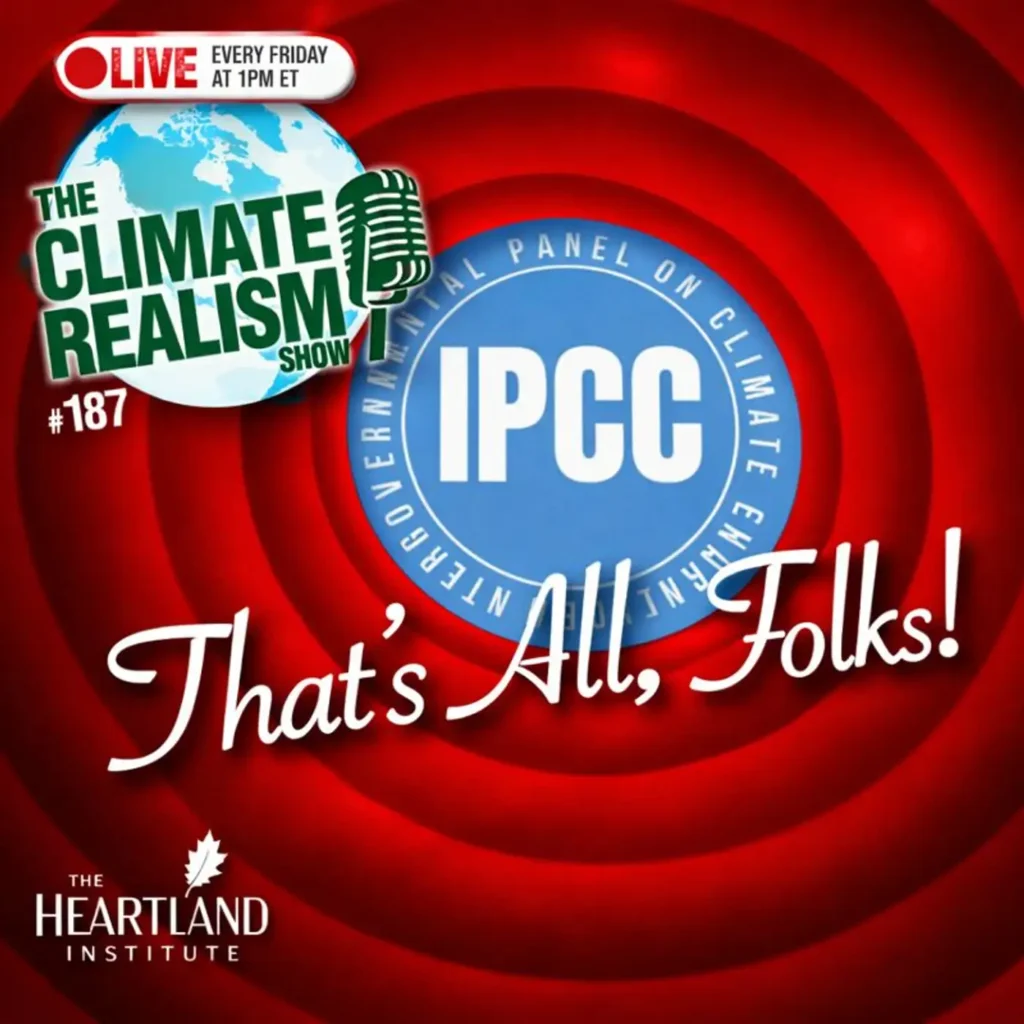Evidence is growing that climate alarmists—those peddling the delusion that human-caused climate change is destroying the Earth—are growing ever-more desperate.
Barely a day goes by without some so-called expert or group proclaiming the world has only one year, two years, 10 years, etc., to reduce fossil-fuel consumption substantially or else it will be too late to prevent multitudes of cascading global disasters that make the biblical plagues of Egypt pale by comparison.
Yet evidence shows people aren’t buying into the climate delusion. This has alarmists acting like used car salespersons, using increasingly dire and shrill language to get people to buy their “product,” which is ever-more-intrusive control over their lives.
For instance, an article in Breitbart notes, “Climate change alarmists are pushing for a change in vocabulary to scare people into taking global warming more seriously, starting with terms like ‘global meltdown’ and ‘climate collapse.’ Writing for AdAge (tellingly, an advertising journal) this week, Aaron Hall argues that in order to get people to ‘take action’ against climate change, ‘rebranding’ is crucial, since people … need to be shocked into the notion that the world as we know it is ending” (emphasis in original).
The push for “rebranding” comes as the United Nations reports governments around the world are failing to meet their greenhouse gas reduction commitments. The U.N.’s 2019 Emissions Gap report says global greenhouse gas emissions have grown by 1.5 percent every year over the past decade, despite governments’ repeated promises their policies would reduce emissions to prevent Earth’s temperature from rising more than 2 degrees Celsius above preindustrial levels. The United Nations says to keep temperatures within supposedly safe limits, governments must cut global emissions by a minimum of 7.6 percent each year between 2020 and 2030.
The problem for climate-delusion pushers is this: Although public opinion surveys taken in recent years usually show at least a slight majority of those surveyed are “moderately,” “very,” or “extremely” certain humans are causing climate change and are worried about it, the polls also consistently show the public isn’t willing to sacrifice much to prevent it.
In an August survey conducted by the Washington Post and Kaiser Family Foundation, for example, more than 60 percent of survey respondents said they believed the world had fewer than 10 years to prevent the worst effects of climate change (with most of those respondents claiming the world has two years or fewer to act). Despite this, 51 percent of those surveyed would be “somewhat” or “strongly” opposed to paying a nominal $2 monthly tax on U.S. residential electric bills to pay for the fight against climate change, and 61 percent would reject a 10 cents per gallon increase in the gasoline tax for that purpose.
More recently, a November survey of 1,000 likely voters conducted by The Heartland Institute and Rasmussen Reports found slightly less than half of those surveyed believe “human activity” is the primary cause of climate change. Even one in three Democrats surveyed rejected the idea. Interestingly, even though 63 percent of those surveyed said they believed it was very or somewhat likely climate change “will be catastrophic for humans, plants, and animals,” few of them were willing to call for dramatic action to prevent it. Only 34 percent of those who believe climate change is primarily caused by humans said the federal or state governments should limit air travel to help prevent it, and just 24 percent said governments should require people to limit their consumption of meat to fight climate change.
The public has backed up its words with actions. When governments in France and Chile pushed energy price increases to limit emissions to fight climate change, people rioted in the streets, eventually forcing their governments to back off proposed fossil fuel price hikes. Elsewhere, voters have replaced government leaders or parties pushing policies to meet their country’s emission reduction targets under the Paris climate agreement with people vowing to rescind energy taxes and focus instead on making energy cheaper and more abundant.
A majority of the public has rejected the climate delusion because they’ve reasonably concluded that although humans may be affecting the climate, the world isn’t going to end and proposals to fight climate change will cause them far more pain and suffering than climate change itself.
This situation has alarmists casting aspersions and looking for scarier “messaging,” as if selling climate change is a marketing campaign rather than an objective matter of science that has an enormous effect on freedom and prosperity.
Enjoy the show!
— H. Sterling Burnett
SOURCES: Breitbart; United Nations Environment Programme; Climate Change Weekly 336; Climate Change Weekly 340; The Heartland Institute
IN THIS ISSUE …
Seventy-five percent of countries missing emission reduction goals … Electric car makers struggle in China and Europe … Climate models, historic data untrustworthy, says top scientist
SEVENTY-FIVE PERCENT OF COUNTRIES MISSING EMISSION REDUCTION GOALS
Hindu Business Line reports a recent analysis by the Universal Ecological Fund (UEF) shows 75 percent of the 184 countries that pledged to reduce their greenhouse gas emissions between 2020 and 2030 are missing their targets, with emissions increasing or slowing much more modestly than necessary to reduce emissions by 50 percent by 2030, the amount assumed necessary in the Paris climate agreement to prevent a 1.5 degree rise in temperature above preindustrial levels.
The report found even though India’s emissions intensity—the amount of greenhouse gas emissions it emits per unit of gross domestic product—has declined by 21 percent since 2005, the country’s overall emissions grew by 76 percent between 2005 and 2017, as its economy has grown.
China has also increased its carbon dioxide equivalent emissions, by 80 percent between 2005 and 2018, while improving its emissions intensity. At the very least, the report says, even if China’s energy efficiency continues to improve, its overall greenhouse gas emissions will continue to rise for at least another decade and possibly longer.
The news gets worse, according to UEF’s analysis, because even if these counties turn things around and meet their greenhouse gas reduction commitments, the specified reductions will still be too little to prevent warming from exceeding the 1.5 degree target.
SOURCE: The Hindu Business Line
ELECTRIC CAR MAKERS STRUGGLE IN CHINA AND EUROPE
In China and Europe, electric vehicles (EV) are struggling to make significant inroads into commercial and consumer transportation markets.
China’s EV makers have struggled to convince consumers to buy more-expensive, less-reliable, battery-powered vehicles, despite lavish government subsidies and restrictions on internal combustion powered vehicles. Now the Chinese government has grown tired of supporting the industry, dramatically reducing its subsidies. After the government scaled back subsidies, electric vehicle sales declined for three straight months, but sales were struggling even before the subsidies were withdrawn, with the growth in sales declining 84 percent year over year.
In Europe, car makers are pleading for more taxpayer support for EV sales as European Union carbon dioxide restrictions on vehicles loom to meet the trading bloc’s greenhouse gas reduction commitments under the Paris climate agreement. European car manufacturers have dramatically increased their production of EVs in order to avoid the financial penalties they face for failing to meet the E.U.’s ambitious fleetwide emission goals requiring car and SUV makers to achieve a fleet average equivalent to 57.4 miles per U.S. gallon by 2021. Fuel economy standards will increase annually until they hit 92 miles per U.S. gallon on average in 2030—effectively requiring almost all cars sold in the EU be electric by 2030. Missing these goals could subject the automakers to fines equivalent to $36 billion, twice the industry’s total estimated profits.
Auto makers point out they can make all the electric and high fuel economy vehicles the E.U. demands, but they can’t force the public to purchase them.
Despite existing subsidies for each electric vehicle sold, the European Auto Manufacturers Association, known by its French acronym, ACEA, reports the EV market share in Germany, Europe’s largest economy and car market, was only 2 percent in 2018, and it was 2.5 percent in Britain, 2.1 percent in France, and less than 1 percent in Italy and Spain. In former Eastern bloc countries, EV sales are even lower, with Poland leading with just 0.2 percent of all vehicles sold.
ACEA warns it will have to raise prices on gasoline and diesel fueled vehicles dramatically to discourage the public from buying them instead of the more expensive EVs, but that will price much of the public out of the market. In order to avoid unfairly reducing the mobility of the middle class and poor, and to keep from putting European automakers out of business, ACEA’s members are calling for more taxpayer money for EVs.
“Mobility must remain affordable for all layers of society,” said Eric-Mark Huitema, ACEA’s director general, Forbes reports. “That is why we are calling on governments to put in place more meaningful and sustainable incentive schemes to stimulate [EV] sales EU-wide.”
CLIMATE MODELS, HISTORIC DATA UNTRUSTWORTHY, SAYS TOP SCIENTIST
In his new book, Confessions of a Climate Scientist: The Global Warming Hypothesis Is an Unproven Hypothesis, Mototaka Nakamura, Ph.D., says much of the stockpile of accumulated data driving the narrative humans are causing catastrophic climate change is untrustworthy. In addition, most of the fearful climate disaster scenarios are based on a the work of a very few climate modelers, making the whole climate crisis theory similar to an upside-down pyramid with the whole teetering edifice built upon a few compromised data points at the base.
“Global mean temperatures before 1980 are based on untrustworthy data,” writes Nakamura. “Before full planet surface observation by satellite began in 1980, only a small part of the Earth had been observed for temperatures with only a certain amount of accuracy and frequency.”
The limited amount of data on historical climate is actually growing less dependable because it is being manipulated by climate modelers and scientists pushing the climate delusion, which Nakamura calls “data falsification.”
“The global surface mean temperature-change data no longer have any scientific value and are nothing except a propaganda tool to the public,” said Nakamura. “The models just become useless pieces of junk or worse (as they can produce gravely misleading output) when they are used for climate forecasting.”
Feeding fudged data into woefully flawed climate models which don’t account for known drivers of climate change such as cloud cover, the earth’s albedo, changes in solar activity, and large- and small-scale shifts in ocean currents produces forecasts that are worse than useless, they are misleading, says Nakamura.
“The real or realistically-simulated climate system is far more complex than an absurdly simple system simulated by the toys that have been used for climate predictions to date … [by] naive climate researchers who have zero or very limited understanding of geophysical fluid dynamics,” writes Nakamura. “Assumptions are made, then adjustments are made to support a narrative. … Our models are mickey-mouse mockeries of the real world.”
SOURCES: Electroverse; World Net Daily



